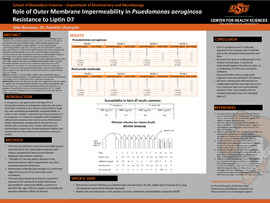| dc.contributor.author | Romoser, Jake | |
| dc.contributor.author | Champlin, Franklin | |
| dc.date.accessioned | 2020-05-05T19:37:59Z | |
| dc.date.available | 2020-05-05T19:37:59Z | |
| dc.date.issued | 2020-02-28 | |
| dc.identifier | ouhd_romoser_roleofoutermembrane_2020 | |
| dc.identifier.citation | Romoser, J., & Champlin, F. (2020, Feb. 28). Role of outer membrane impermeability in Pseudomonas aeruginosa resistance to liptin d7. Poster presented at Research Day at Oklahoma State University Center for Health Sciences, Tulsa, OK. | |
| dc.identifier.uri | https://hdl.handle.net/11244/324245 | |
| dc.description.abstract | BACKGROUND: Pseudomonas aeruginosa is an opportunistic pathogen that is intrinsically resistant to hydrophobic molecules, yet is susceptive to chemical sensitization by low concentrations of the biocide triclosan using the outer membrane permeabilizer compound 48/80. In order to obtain a better understanding of these properties in P. aeruginosa, it was decided to examine disparate hydrophobic substances thought to also possess antibacterial potential. Researchers working with Dr. Dennis Burns at Wichita State University have recently synthesized and characterized a novel class of picket porphyrins (liptins) and showed them to have antibacterial properties in previous studies. | |
| dc.description.abstract | METHODS: Minimal inhibitory concentrations (MICs) were determined for a model liptin molecule (d7) using a conventional macro-broth dilution bioassay. Pasteurella multocida was included as a reference organism because of its permeable outer membrane. The next steps would have been to repeat the analysis in the presence of outer membrane permeabilizer compound 48/80, as well as to perform disc agar diffusion assays to eliminate possible bactericidal interference by the solvent. | |
| dc.description.abstract | RESULTS: The liptin d7 did not readily dissolve in absolute ethanol, thereby resulting in a turbid suspension at concentrations necessary for this study. P. aeruginosa and P. multocida were both found to be resistant to liptin d7 with MICs of 32 and 64 ug/mL, respectively. | |
| dc.description.abstract | CONCLUSION: Because the MICs were so high, especially with respect to P. multocida which was expected to be susceptible, both organisms were deemed liptin d7 resistant. We were subsequently informed by our collaborators that the liptin derivative sent to us may have been incorrectly labeled and was in fact a less soluble and less inhibitory derivative than the intended liptin d7. This halted further study of the compound due to an inability to obtain the more soluble active form to perform the analyses. | |
| dc.format | application/pdf | |
| dc.language | en_US | |
| dc.publisher | Oklahoma State University Center for Health Services | |
| dc.rights | The author(s) retain the copyright of have the right to deposit the item giving the Oklahoma State University Library a limited, non-exclusive right to share this material in its institutional repository. Contact Digital Resources and Discovery Services at lib-dis@okstate.edu or 405-744-9161 for the permission policy on the use, reproduction or distribution of this material. | |
| dc.title | Role of outer membrane impermeability in Pseudomonas aeruginosa resistance to liptin d7 | |
| osu.filename | ouhd_romoser_roleofoutermembrane_2020.pdf | |
| dc.type.genre | Presentation | |
| dc.type.material | Text | |
| dc.subject.keywords | liptin | |
| dc.subject.keywords | macro-broth dilution bioassay | |
| dc.subject.keywords | susceptibility | |
